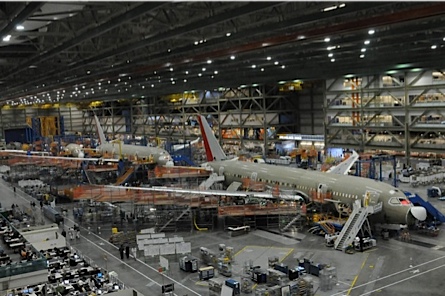Boeing will surge 787 production early to meet customer demand as part of the establishment of the newly announced Charleston 787 second line.
Boeing says that until the second 787 line is brought on line, the company will establish "transitional surge capability" on the existing Everett line in Washington to "ensure the successful introduction of the 787-9", which has a planned service entry at the end of 2013 with Air New Zealand.
According to programme sources, Boeing will establish an interim 787 "surge" assembly line in addition to the primary final assembly line inside the 40-26 Building at Everett.
The surge line will be housed on the current 767 line, inside the 40-24 Building, while the Everett factory will be modified to feed low-rate 767 production out of the rear of the existing line.
The surge line will eventually be phased out as the Charleston line becomes operational, shifting manufacturing capacity to the company's first final assembly operation outside the USA's Pacific Northwest.
 |
|---|
© Boeing |
"We're taking prudent steps to protect the interests of our customers as we introduce the 787-9 and ramp up overall production to 10 787s per month," says Boeing Commercial Airplanes chief executive Jim Albaugh.
As a part of the 10-a-month ramp-up by the end of 2013, programme sources say, seven 787s a month will be completed in Everett, while the balance will be built in Charleston.
This assessment meshes with comments by Washington state Governor Chris Gregoire, who said that the Charleston line would only build "35 or 36" 787s a year.
Boeing announced 28 October that North Charleston, South Carolina will host the second 787 final assembly line.
"Establishing a second 787 assembly line in Charleston will expand our production capability to meet the market demand for the airplane," says Albaugh.
The North Charleston site is responsible for the fabrication and integration of the 787's aft fuselage at Boeing Charleston, as well as the integration of the centre fuselage as part of Global Aeronautica, a 50-50 joint venture with Alenia Aeronautica.
Boeing acquired the Boeing Charleston facility, formerly owned and operated by Vought Aircraft Industries, in July. The 50% share of Global Aeronautica, also previously owned by Vought, was purchased in March 2008.
"This decision allows us to continue building on the synergies we have established in South Carolina with Boeing Charleston and Global Aeronautica," adds Albaugh.
The primary line in Everett became operational with the start of final assembly operations for the first 787 (ZA001) in May 2007.
Since that time, Boeing has struggled with design issues and supply chain management problems as it works to complete the 787's maiden sortie by the close of 2009 after more than two years of delays.
The announcement came less than a day after reports that negotiations between Boeing and its biggest union, the International Association of Machinists and Aerospace Workers, had collapsed, making the selection of Charleston virtually inevitable.
Boeing had sought a no-strike agreement from the IAM, but the parties were not able to reach a compromise that would have kept the second line in Washington state.
Boeing had narrowed down its choices in recent weeks between North Charleston and Everett.
The first 787 is due to be delivered to Japan's All Nippon Airways in the fourth quarter of 2010. Boeing holds 840 orders from 55 customers for Dreamliners.
Source: Flight International
















